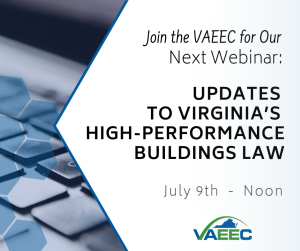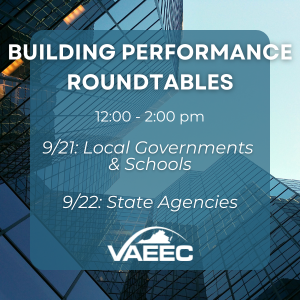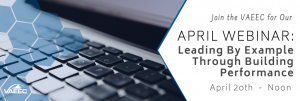 The High Performance Buildings Act of 2021 was enacted to drive more efficient, resilient, and future proof buildings. It updated the building performance standards for state and public buildings and created new building performance standards for local governments. During the 2024 General Assembly Session, the VAEEC and other stakeholders worked with the bill patron to update the law to better suit the localities’ needs and clarify unanswered questions.
The High Performance Buildings Act of 2021 was enacted to drive more efficient, resilient, and future proof buildings. It updated the building performance standards for state and public buildings and created new building performance standards for local governments. During the 2024 General Assembly Session, the VAEEC and other stakeholders worked with the bill patron to update the law to better suit the localities’ needs and clarify unanswered questions.
The major changes to the law, which takes effect July 1st, include:
- Clarification of the definition of “appropriate resilience features”. The bill language allows localities to identify potential hazards and determine what measures are effective to mitigate those risks to their specific buildings. This allows for more flexibility, as a coastal locality may have very different needs from one in the Piedmont or Southwest Virginia.
- Removal of the Virginia Energy Conservation and Environmental Standards (VEES) as a high performance building certification program, and inclusion of Earthcraft Light Commercial certification for buildings under 50,000 square feet. The VEES is not consistently updated, so removing it as a potential certification ensures deeper energy savings and higher standards in line with LEED, Earthcraft, and Green Globes.
- Specifying that the term “locality” is inclusive of school systems. In many Virginia cities and counties, the school system is a separate entity from the local government, which led to confusion about which buildings were included under the law.
- Closing loopholes in the definition of Zero Emission Vehicle (ZEV) charging infrastructure and the timeline for the design phase of a building. Both sections of the 2021 law included language that confused the intent of the law and made it easy to seek exemption from the requirements. The 2024 update strikes language around the number of charging stations and types of chargers required, and plainly states what types of equipment should be considered in the design phase of the building. It also adds a timeline for localities to enter the design phase after budgeting and contracting for the work.
- Clarification on how to adapt buildings that don’t qualify for high performance building standards, such as firehouses. The 2024 law now states that, if a building type is under 20,000 square feet and not eligible for certification, that the locality must model energy savings equivalent to the ENERGY STAR Target Finder value for the building type, or equivalent standards.
The 2024 update also includes sections that added definitions for “commissioning” and “major disruption” to further ensure that new and renovated public buildings are achieving maximum comfort, health, and energy savings, while also allowing the localities the flexibility to do what is best for their community.
For a deeper dive into the nuts and bolts of the High-Performance Buildings Act, register for our upcoming webinar on July 9th.
 Virginia’s High-Performance Buildings Act (HB2001) was signed into law in 2021, with the goal to drive more efficient, resilient, and future-proof buildings. The law updated the building performance standards for state/public buildings by adding electric vehicle charging and infrastructure and utility metering requirements. It also created new building performance standards for local governments.
Virginia’s High-Performance Buildings Act (HB2001) was signed into law in 2021, with the goal to drive more efficient, resilient, and future-proof buildings. The law updated the building performance standards for state/public buildings by adding electric vehicle charging and infrastructure and utility metering requirements. It also created new building performance standards for local governments.
Since the act was introduced in the General Assembly, the VAEEC and key partners have been working with the bill patron and others to clarify the requirements and identify potential updates to the existing law. This included working with the Department of General Services (DGS) to update the Virginia Energy Conservation and Environmental Standards (VEES) for the first time since 2012.
 In September of this year, we held two building performance roundtable discussions with localities, state agencies, schools, architecture and design firms, engineering firms, and energy service companies. The goals were to educate stakeholders about the requirements and identify ways to update the law so that it better suits the needs of the intended audience.
In September of this year, we held two building performance roundtable discussions with localities, state agencies, schools, architecture and design firms, engineering firms, and energy service companies. The goals were to educate stakeholders about the requirements and identify ways to update the law so that it better suits the needs of the intended audience.
VAEEC Board members Elizabeth Beardsley (U.S. Green Building Council) and Bryna Dunn (Moseley Architects) started off the roundtables with an overview of the law and the pathways to compliance.
By July 1, 2021, state agency buildings were mandated to:
- Be designed, constructed, verified, and operated to comply with a high-performance building certification program,
- Comply with VEES,
- Have sufficient zero-emission vehicle infrastructure, and
- Include features that measure energy consumption and associated carbon emissions.
In the law, there is an option to exceed the above design and construction standards with prior written approval from the Director of DGS. The Director of DGS can also grant exemptions for specific projects if it is impractical to build or renovate to the standards. HB2001 also added a new reporting requirement for state agencies: an annual report is due to the Governor by January 1st detailing the energy efficiency and associated carbon emissions metrics for each applicable building built or renovated during the prior fiscal year.
Beginning July 1, 2021, buildings for localities with populations of 100,000 or more must:
- Be designed, constructed, verified, and operated to comply with one of three high-performance building certification programs (LEED certification, Green Globes Certification, or VEES verification),
- Have sufficient zero-emission vehicle charging and fueling infrastructure,
- Include features that measure the energy consumption and associated carbon emissions, and
- Incorporate appropriate resilience and distributed energy features.
Remaining localities will need to abide by these requirements beginning July 1, 2023.
Localities can seek an exemption if it is impractical to build or renovate to the standards. Local governments also have the option to adopt their own green design and construction program with standards that are more stringent than those required by law.
The above mandates apply to new buildings over 5,000 square feet and renovations where the cost of the renovation exceeds 50% of the value of the building. Smaller projects (those that are less than 20,000 gross square feet in size) have the option to achieve an ENERGY STAR certification with the implementation of mechanical, electrical, plumbing, and envelope commissioning instead.
The three compliance pathways are LEED certification, Green Globes Certification, or VEES verification. LEED v4 is the newest version of the LEED green building certification. A building must comply with a set of prerequisites, but then you can select a minimum number of criteria depending on what makes the most sense for your building. Similarly, Green Globes provides the option to pick and choose a minimum number of criteria, but this certification program does not have prerequisites. VEES follows the International Green Construction Code, so a building must comply with all of the stated requirements.
Guidance, resources, and support exist to help state agencies and local governments navigate and meet the law’s requirements. Starting October 1st, the Southeast Energy Efficiency Alliance (SEEA) will be providing technical assistance with policy creation and stakeholder engagement. They will also be providing technical assistance and training on the Building Energy Analysis Manager (BEAM) tool, which helps states and communities achieve building energy policy goals.
Additionally, Moseley Architects created a Requirements Summary for HB2001, which includes an option comparison. The U.S. Green Building Council (USGBC) curated two resources specific to green building in Virginia, Getting Started with High Performance Green Building: A Guide for Virginia Localities and VA HB2001: Summary & FAQ for Local Governments. USGBC also created Inflation Reduction Act: Buildings Provisions, which state agencies and localities will find helpful as they navigate the opportunities in the Inflation Reduction Act. These resources can be viewed at the respective links above, as well as in the VAEEC government clearinghouse. The clearinghouse also includes additional green building resources for our local government, academic, and state agency members.
Facilitated discussions took up the remainder of the event. Attendees were encouraged to ask questions and provide feedback, including:
- What part(s) of the legislation is consistent with objectives already set by your locality/agency?
- What part(s) of the legislation is helping move forward objectives that your locality/agency supports but doesn’t already have policies around?
- What clarifications or additions would you offer to update the current language?
- How can VAEEC and our partners support you in meeting your sustainability goals and the requirements of this legislation?
The presentation PDFs are available to download (local governments and schools, state agencies), and recordings of both roundtables can be viewed on the VAEEC YouTube channel. To learn more about building performance, register to attend our Energy Efficiency Forum on October 31st (virtual) and November 1st (in-person, Richmond). Additional questions can be addressed to Jessica Greene (jessica@vaeec.org).
 The VAEEC recently hosted a webinar on building performance primarily for local governments across the Commonwealth. Leading By Example Through Building Performance followed three different building performance policies and programs to not only encourage the audience to implement their own strong green building policy but to also provide best practices and lessons learned from the design phase all through the day-to-day management of a program.
The VAEEC recently hosted a webinar on building performance primarily for local governments across the Commonwealth. Leading By Example Through Building Performance followed three different building performance policies and programs to not only encourage the audience to implement their own strong green building policy but to also provide best practices and lessons learned from the design phase all through the day-to-day management of a program.
Speakers included:
- Dawn Oleksy, Climate Action Programs & Operations Supervisor, City of Richmond
- Bill Eger, Energy Manager, City of Alexandria
- Holly Savoia, Director of Sustainability Enforcement, NYC Department of Buildings, and
- Elizabeth Beardsley, Senior Policy Counsel, U.S. Green Building Council.
With Virginia being a Dillon Rule state, localities are limited as to what they can and cannot mandate. However, jurisdictions are finding ways to make progress happen in their communities.
The webinar began with an overview of green buildings and the benefits of a strong green building policy – such as energy savings, emission reductions, and improved air quality – from Liz. Next, Dawn covered the City of Richmond’s climate action policy, RVAgreen 2050, which the City is currently in the middle of developing. RVAgreen 2050 centers around three key points: equity, climate action, and climate resilience. Buildings & Energy is one of five pathways the City is using to meet its goal of achieving net-zero emissions by 2050 and becoming more climate-resilient. This includes requiring an equitable building performance policy for existing commercial buildings, retro-commissioning for existing commercial buildings to improve efficiency, and benchmarking existing commercial buildings.
RVAgreen 2050 is equitable climate action for a healthy and resilient Richmond.
Dawn specified the need for stakeholder engagement throughout the entire process in order to better understand the community’s priorities. She also shared RVAgreen 2050’s measuring process to track the plan’s outcomes and the shared accountability framework to encourage transparency, a culture of improvement, trusting relationships, institutionalizing sustainability in city government, and regular evaluation.
Richmond just began the next phase of community-wide engagement to gather feedback on the plan. RVAgreen 2050 is scheduled to be finalized this summer and adopted by fall.
Next, Bill provided an overview of the City of Alexandria’s Green Building Policy. The City initially enacted this policy in 2009. Alexandria created the Environmental Action Plan 2040 to support the City’s goals, which include climate action and energy reduction.
The Green Building Policy establishes minimum green building practices for new public and private development and major renovations.
To work around Virginia’s “constrained policy environment”, authority for this policy is rooted in the City’s zoning code. Certain building performance conditions are required for the Development Site Plan and Development Special Use Permit review processes. New development must achieve the LEED Silver level of certification at a minimum. Using a third-party rating system provides an expert verification of meeting compliance requirements without having to have experts on staff. The policy also includes a minimum threshold requirement for a number of community priorities, such as energy efficiency, renewable energy, and advanced energy metering.
The Green Building Policy was updated in 2019 to include newer concepts such as decarbonization. In the ten-year span between 2009 and 2019, over 95% of the development square footage constructed or currently under construction in Alexandria is compliant with the 2009 policy. This equates to nearly 10 million square feet of green building development.
Holly provided an overview of New York City’s Energy Grades Program, including the local sustainability laws that led to this program. PlaNYC set out to reduce the City’s emissions by 30% by 2030. The Greener, Greater Buildings Plan paved the way for benchmarking, energy audits and retro-commissioning, and lighting upgrades and sub-metering. Then, after Hurricane Sandy hit, the One City Built to Last Policy increased the emissions reduction goal to 40% by 2030 and 80% by 2050.
Commercial benchmarking served as the precursor to the City’s Energy Grades Program.
Since it provides transparency of a property’s annual energy and water usage, benchmarking is seen as the first step for building owners or tenants to make a building more efficient – you can’t change what you can’t measure.
The City’s commercial benchmarking mandate originally applied to buildings over 50,000 SF, but was later amended to apply to any building over 25,000 SF. Building owners must report their building’s energy and water consumption annually through the U.S. EPA’s Energy Star Portfolio Manager. Portfolio Manager is a readily accessible, free tool, so the municipality did not have to purchase it or develop their own benchmarking software. Additionally, building owners do not have to pay to use it or hire someone else to input the data, which helps lead to higher compliance rates. New York City has also created a way for building owners to automatically upload their data from their utility bills. Initially, violation fees were issued once a year. Now that they are issued on a quarterly basis, the City has a 96% compliance rate.
New York City’s Building Energy Grades Program applies to most buildings over 25,000 SF. The Department of Buildings uses a building’s benchmarking data to assign qualified buildings a letter grade distribution based on their Energy Star score. Owners are required to post their building’s Energy Efficiency Rating Label in a conspicuous location of their building’s entrance. The program provides transparency of a property’s energy efficiency to the public.
One of the key takeaways from all the speakers is the importance of getting the private sector involved early in the policy-making process. Getting them involved from the beginning not only increases buy-in but also allows localities to understand challenges that they may not have foreseen and to brainstorm solutions.
It was inspiring to see all of the thought and effort that goes into developing, implementing, and managing green building policies.
A recording of the webinar can be viewed here. Contact info@vaeec.org for more information.
 The High Performance Buildings Act of 2021 was enacted to drive more efficient, resilient, and future proof buildings. It updated the building performance standards for state and public buildings and created new building performance standards for local governments. During the 2024 General Assembly Session, the VAEEC and other stakeholders worked with the bill patron to update the law to better suit the localities’ needs and clarify unanswered questions.
The High Performance Buildings Act of 2021 was enacted to drive more efficient, resilient, and future proof buildings. It updated the building performance standards for state and public buildings and created new building performance standards for local governments. During the 2024 General Assembly Session, the VAEEC and other stakeholders worked with the bill patron to update the law to better suit the localities’ needs and clarify unanswered questions. 
 Virginia’s
Virginia’s  In September of this year, we held two building performance roundtable discussions with localities, state agencies, schools, architecture and design firms, engineering firms, and energy service companies. The goals were to educate stakeholders about the requirements and identify ways to update the law so that it better suits the needs of the intended audience.
In September of this year, we held two building performance roundtable discussions with localities, state agencies, schools, architecture and design firms, engineering firms, and energy service companies. The goals were to educate stakeholders about the requirements and identify ways to update the law so that it better suits the needs of the intended audience.  The VAEEC recently hosted a webinar on building performance primarily for local governments across the Commonwealth. Leading By Example Through Building Performance followed three different building performance policies and programs to not only encourage the audience to implement their own strong green building policy but to also provide best practices and lessons learned from the design phase all through the day-to-day management of a program.
The VAEEC recently hosted a webinar on building performance primarily for local governments across the Commonwealth. Leading By Example Through Building Performance followed three different building performance policies and programs to not only encourage the audience to implement their own strong green building policy but to also provide best practices and lessons learned from the design phase all through the day-to-day management of a program.